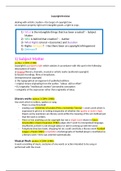Summary
Intellectual Property Law: Copyright Summary, Cases and Statues.
- Module
- Intellectual Property Law
- Institution
- The University Of Kent (UKC)
These revision notes are a culmination of IP Lectures on Copyright, Seminar Classes and IP textbooks. They cover cases, highlighted key words, summaries, statute and full references to the Intellectual Property textbook. All broken down in stages and colour coding over 14 pages of good old Copyrigh...
[Show more]











